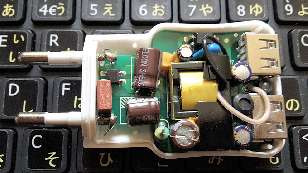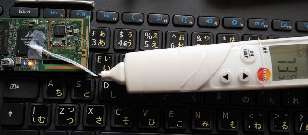Rick's b.log - 2016/09/04
You are 3.15.6.140, pleased to meet you!
Rick's b.log - 2016/09/04 |
|
| It is the 24th of November 2024 You are 3.15.6.140, pleased to meet you! |
|
mailto: blog -at- heyrick -dot- eu
I had thought at first that Vonets VAP11G had failed short circuit, but this does not appear to be the case. It now seems that the power supply failed, which may or may not have damaged the VAP11G.
The reason I say this hesitantly is that on the day of failure, the VAP11G was utterly dead. I tried it again on... Thursday, I think, and the VAP11G would start up and connect to the WiFi network, but would die the moment it had to actually send or receive any data. And today? It connected and handled pinging Google's DNS server (8.8.8.8) for five minutes (I stopped it then).
I have gone and got myself another power lug. Here's a photo of the inside of the old one, which is now no longer capable even of lighting up an LED lamp:
The behaviour of the Vonets is certainly interesting. I grew up with the idea that "broken means broken" (you know, like "brexit means brexit", not that there's much difference between the two statements). It is certainly eyebrow raising to have a broken thing limping back to life.
What worries me is that the Vonets has a tendency to run hot. Well, today I tested the Vonets and this time put a temperature probe on it. The probe is one salvaged from work, it's pretty reliable (has to be), just some dope went and broke the pokey-proddy part. Ironically, that's more useful for me as I could tape the sensor to the chip without worrying about inaccurate readings due to ambient air cooling the majority part of the metal sensor. I tested this, by the way, and the difference with and without the metal outer was about 15°C - because the heat was only coming from one specific place.
I have ordered another VAP11G. There are other models available these days, but I know this thing works, once you get over the obnoxious setup requirements (a weird non-standard protocol that requires WinPCap and Windows XP).
Since I have the Vonets open...
There are four principal ICs:
Aaaanyway. This long winded explanation is to explain why my personal (Pi) server won't respond if you try talking to it. Those of you who know the URL, that is...
Pop! Bang!
The other day, I noticed my personal server was down. Not only down, but the Vonets WiFi adaptor was dead and the Pi was stuck in a cycle of continually blinking its red power LED, like it was trying to start up but never quite making it.

Anyway, while the Pi was pinging, the temperature quickly rose to 68°C, and then slowed down. It was still climbing, just not as dramatically. In a few minutes in free air, the temperature of the SoC reached 73.5°C. It was still climbing, slower this time. The presence of the tape didn't make much difference, for what it's worth. Now imagine the Vonets inside its enclosure, relying purely upon air convection, though it's not as if the air holes in the casing help much here.
The other chips (Flash, RAM, and WiFi) also run worryingly hot.

I have also ordered a tiny fan - 25mm 5V, 100mA. I intend to punch a hole in the plastic casing and fit the fan to it, to force-cool the innards of the Vonets. As it runs off 5V, I can just piggyback it to the USB power source. If the old Vonets fails or is unreliable, I'll just swap cases and use the cooling with the new one.
Not much information on this. As far as can be determined, it is a WiFi/Ethernet capable SoC based around an ARM9 core. It is possibly running a custom RTOS, and clocking ~160-200MHz.
8MiB RAM.
1MiB FlashROM.
The name says it all really. It's the RF baseband transceiver, containing a CMOS amplifier, low noise amplifier, VCO, and frequency synthesiser. As this is the VAP11G, this part supports the 802.11b and 802.11g modulation schemes.
No comments yet...
| © 2016 Rick Murray |
This web page is licenced for your personal, private, non-commercial use only. No automated processing by advertising systems is permitted. RIPA notice: No consent is given for interception of page transmission. |